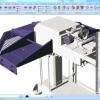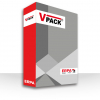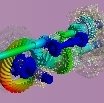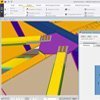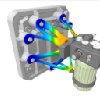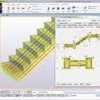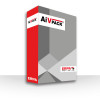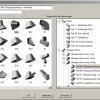Simcenter FloEFD - CFD Frontloading - Design - Simulate - Build!
FloEFDTM for Creo« | FloEFDTM for CATIA V5 | FloEFDTM for NX« | FloEFDTM for Solid Edge«
Simcenter FloEFD is an excellent and powerful front-loading CFD simulation solution for designers dealing with complex design challenges.
Incorporating CFD simulation early in the design process allows designers to evaluate design options and optimize product performance and reliability early as well. By using the most innovative technology, FloEFD opens the world of fluid dynamics analysis to a wider range of users.
CFD offers great benefits to the user to understand the behavior of the design earlier and thereby reduce less attractive options.
FloEFD is a design simulation tool
As an embedded application, FloEFD is fully integrated with the most popular CAD programs (CATIA, Creo, NX, Solid Edge, ...) on the market.
FloEFD can be easily integrated with familiar PLM software and provides compressed time scales for product development processes during the creation and testing of the digital twin.
Simcenter FloEFD is easy to use and provides MCAD users with an intuitive user experience. The powerful analysis wizard guides you through problem setup, analysis and visualization of results. Most users are able to work efficiently with the software after eight hours of training. The software offers the widest choice of local language implementations to make the analysis as accessible as possible.
FloEFD is accurate
The software is easy to use, yet accurate. The accuracy of FloEFD results has already been verified by thousands of companies using the software to solve complex design problems. The intelligent technology at its core is what makes FloEFD as accurate as other CFD software, but without the burden that other systems require.
FloEFD is fast
With FloEFD, you don't sacrifice speed for accuracy. FloEFD is fast. It's so fast that it can reduce overall simulation time by up to 75%.
FloEFD Features
- equilibrium volume condensation of water from steam and its influence on fluid flow and heat transfer.
- heat conduction in liquid, solid and porous media with/without conjugate heat transfer and/or contact heat resistance between solids
- subsonic, transonic and supersonic gas flows, hypersonic air flows with equilibrium dissociation and ionization effects
- radiative heat transfer between opaque solids, absorption in semi-transparent solids, and refraction in semi-transparent and transparent solids
- volume (or surface) heat sources, e.g., due to Joule heating, Peltier effect, etc.
- different types of thermal and electrical conductivity in the solid medium, i.e., isotropic, unidirectional, biaxial/axisymmetric, and orthotropic
- water film development (surface condensation/evaporation, melting/freezing, film motion).
- fluid flows with boundary layers, including wall roughness effects
- fluid flows in models with moving/rotating surfaces and/or parts
- joule heating by direct electric current in electrically conducting solids
- compressible gas and incompressible fluid flows
- relative humidity in gases and gas mixtures
- multispecies fluids and multicomponent solids
- fluid flows and heat transfer in porous media, steady-state and time-dependent fluid flows
- cavitation in water and other fluids
- free, forced and mixed convection
- combustion in gas phase mixtures
- two-phase flows (fluid + particles)
- laminar and turbulent fluid flows
- flows of non-Newtonian fluids
- external and internal fluid flows
- real gases with phase change
- flows of compressible fluids
- FEA bridges including Mechanica, Patran, MpCCI and SolidWorks structural analysis
optional additions
- Electronic cooling module: In addition to advanced databases of fan curves and packaging material or 2-resistor components, it also includes special features and physics such as a PCB model and Joule heating due to current flow.
- LED Module: The LED module is the ideal module for the lighting industry and especially for LEDs. It contains a new unique LED model that provides junction temperature and hot lumen.
- Advanced Module: It provides the ability to consider hypersonic flow for up to Mach 30 and combustion.
- HVAC module: special simulation capabilities for comfort and safety for occupied spaces such as buildings and transport vehicles.
- EDA Bridge: Import data from EDA software such as Mentor Expedition, Cadence, Zuken and Altium.



